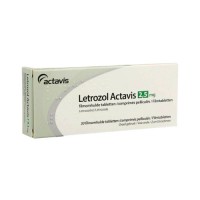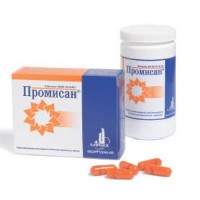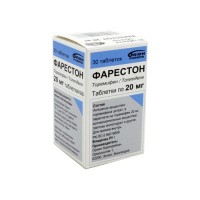Tamoxifen 20mg (30 tablets)
- $15.30
Out Of Stock
The instruction for medical use of medicine Tamoxifen the Trade name Tamoxifen the International unlicensed name Tamoxifen Dosage Form of the Tablet of 20 mg Structure One tablet contains active agent - tamoxifen citrate of 30.4 mg (it is equivalent to tamoxifen of 20 mg), excipients: lactoses monohydrate, cellulose microcrystalline, magnesium or calcium stearate, silicon dioxide colloidal anhydrous the Description of the Tablet of white color of a ploskotsilindrichesky form with an engraving of the letter G on the one hand and crosswise risky on the other hand Pharmacotherapeutic group Antineoplastic hormonal drugs. Hormones antagonists and their analogs. Anti-estrogen. Tamoxifen. The ATX L02BA01 code the Pharmacological Pharmacokinetics Later properties of intake tamoxifen is well soaked up. The maximum concentration in serum is reached ranging from 4 till 7 o'clock after reception of a single dose. Equilibrium concentration of tamoxifen in blood serum is usually reached after 3-4 week receptions. It is metabolized in a liver with formation of several metabolites. Removal of tamoxifen from an organism has two-phase character with an initial stage of semi-removal from 7 to 14 hours and with the subsequent slow terminal elimination half-life within 7 days. It is allocated mainly in the form of conjugates, generally with stool, only its small amounts are distinguished with urine. The pharmacodynamics Tamoxifen is the nonsteroid anti-estrogenic means having also weak estrogenic properties. Its action is based on ability to block receptors of estrogen. Tamoxifen and also some of its metabolites compete with oestradiol for places of linking with cytoplasmatic receptors of estrogen in tissues of a mammary gland, uterus, vagina, a front share of a hypophysis and tumors with the high content of receptors of estrogen. Contrary to a receptor complex of estrogen, the receptor complex of tamoxifen does not stimulate synthesis of DNA in a kernel, and cell division oppresses that leads to regression of tumor cells and their death. Indications - cancer therapy of a mammary gland - treatment of anovulatory infertility the Route of administration and doses 1. Cancer of mammary glands Adults the Usual recommended daily dose of tamoxifen makes 20 mg. At reception of higher doses of an additional premushchestvo in the form of later development of a recurrence or improvement of survival of patients. Data, 30-40 mg confirming use a day are inaccessible for treatment in spite of the fact that they were applied to treatment of patients with more extensive diseases. Elderly patients the Similar mode of dosing was applied at elderly patients with cancer of mammary glands, and at some patients – as monotherapy. 2. Anovulatory infertility Before purpose of a course of the therapy initiating or the subsequent, it is necessary to exclude possible pregnancy. For women with a regular, but anovulatory menstrual cycle, the initiating dose 20 mg a day, appointed to the 2nd, 3rd, 4th and 5th day of a menstrual cycle are. In case of the unsatisfactory basal temperature or insufficiency of pre-ovulatory cervical slime, the subsequent course of treatment during further menstrual cycles with increase in a dose to 40, and then up to 80 mg a day can be appointed. At women the initiation of treatment can happen to a regular menstrual cycle in any day of a cycle. In case of lack of signs of an ovulation, the subsequent course of treatment can be begun 45 days later after completion of the previous treatment with increase in a dose as it is described above. Pediatric population Use of tamoxifen for children is not recommended. The profile of efficiency and safety of tamoxifen at children is not established. A pill should be taken orally. Side effects At long-term treatment by-effects were shown mainly in light severity. At development of side effects of heavy severity it is possible to reduce a dose of drug (to not less than 20 mg/days) without loss of control of a disease. If by-effects remain in the same degree, the therapy termination is possible. Cerebrovascular disorders: some messages show that intake of tamoxifen is associated with the increased risk of cerebrovascular disorders. Disturbances of the visual device: some cases of visual disturbances (including reports on indistinct sight, decrease in visual acuity, an optic neuritis, change of an eye corner and a retinopathy) and the increased frequency of development of a cataract were observed at the patients receiving therapy by tamoxifen. It was reported about cases of neuropathy of an optic nerve and an optic neuritis at the patients receiving tamoxifen, and in certain cases, the blindness developed. Disturbances from digestive tract: intolerance digestive tract, nausea, vomiting. General disturbances: fatigue, spasms of legs Hematologic disturbances: decrease in quantity of thrombocytes to 80000-90000 on 1 cm3, and in certain cases below, at the patients receiving tamoxifen as therapy for cancer therapy of a mammary gland. After the beginning of intake of tamoxifen the leukopenia in certain cases connected with anemia and/or thrombocytopenia was observed. About cases of a neutropenia it was reported seldom, the neutropenia of heavy severity in certain cases developed. Gepatobiliarny disturbances: use of tamoxifen is associated with change of level of enzymes of a liver, in certain cases with development of heavy deviations, including a cholestasia, not alcoholic steatogepatit also cirrhosis. Tamoxifen potential concerning development of not alcoholic steatogepatit and cirrhosis is connected with the following risk factors: excess weight or obesity, insulinrezistentnost, diabetes, lipidemia. The phenomenon of not alcoholic steatogepatit is reversible at tamoxifen cancellation. Immunological disturbances: rare reactions of hypersensitivity, including a Quincke's disease. Metabolic disturbances: increase in weight, liquid delay. At a small amount of patients from matastaza in bones the hypercalcemia in an initiation of treatment tamoxifen developed. The increase in serumal level of the triglycerides which in certain cases were followed by pancreatitis, connected with intake of tamoxifen was in rare instances observed. Benign new growths, malignant new growths and undifferentiated new growths (including cysts and polyps): flash of growth of a tumor and pain syndrome. Increase in frequency of development of endometrial cancer and sarcoma of a uterus (mainly mixed malignant new growths Mullerov). Risk of developing endometrial cancer increases about increase in a daily dose of tamoxifen and the prolonged therapy mode. Disturbances from nervous system: headaches, levity. Mental disturbances: confusion, depression. Reproductive disturbances: vaginal bleeding, discharges from a vagina, an itching of a vulva. At a part of the women of reproductive age receiving tamoxifen as therapy of a breast cancer the menstrual cycle is suppressed. It was reported about cases of a hysteromyoma, endometriosis and other endometrial changes, including a hyperplasia and polyps. Cystous hypostasis of ovaries at the women of reproductive age receiving tamoxifen is in certain cases observed. Respiratory disturbances: seldom or never cases of an interstitial pneumonitis. Skin disturbances: rash (including separate cases of a multiformny erythema, Stephen-Jones's syndrome and bullous pemphigoid), xeroderma, an alopecia. In rare instances beam dermatitis develops. Vascular disturbances: inflows, cases of a deep vein thrombosis and pulmonary embolism during therapy by tamoxifen. At use of tamoxifen in a combination with cytotoxic agents, the increased risk of development of the thromboembolic phenomena is observed. Contraindications Tamoxifen should not be applied in the following cases: - during pregnancy. The patients who are in a premenopauza need to be examined carefully for a pregnancy exception prior to treatment, - hypersensitivity to active components or to any other component of drug, - the accompanying use of an anastrozol, - treatment of infertility. Patients with personal or hereditary history the confirmed venous thrombembolia, - children's age up to 18 years. Medicinal interactions Antibacterial drugs: tamoxifen is exposed to metabolism by P450 cytochrome CYP3A4 isoenzyme therefore it is necessary to be careful at use with the drugs inducing activity of enzyme, such as rifampicin as concentration of tamoxifen can decrease. At combined use of tamoxifen with coumarinic anticoagulants, the anticoagulating effect can increase considerably. At making decision on joint appointment, it is necessary to carry out careful monitoring of a condition of the patient. Other hormonal antagonists: tamoxifen can reduce plasma concentration of letrozole. Use of tamoxifen in a combination with letrozole as adjuvant therapy did not show considerable improvement of efficiency in comparison with monotherapy by tamoxifen. Cytostatics: hemolytic anemia, thrombocytopenia, the renal dysfunction conducting to potentially fatal hemolytic uraemic syndrome can develop at the patients receiving tamoxifen with or at short notice after reception of a mitomitsin. The accompanying use of tamoxifen with cytostatics ovyshatsya risk of development of the thromboembolic phenomena. It is necessary to take measures for prevention of thrombosis at the patients receiving tamoxifen to a naruda with chemotherapy. Also in literature it is reported about cases of decrease in plasma concentration for 65-75% of one or more active metabolites of drug, including the endoxyhair dryer. Decrease in efficiency of tamoxifen was observed against the background of intake of selective serotonin reuptake inhibitors (for example, paroksetin) in some researches. Because it is impossible to exclude decrease in effect of tamoxifen at combined use with potential CYP2D6 inhibitors (for example, paroksetin, fluoxetine, quinidine, tsinakaltst or bupropion), similar combinations should be avoided. Special instructions Patients with rare hereditary intolerance of a galactose, Lapp's laktaznoynedostatochnost or glucosic galaktoznoy malabsorption should not take this drug. The increased frequency of development of endometrial changes, including a hyperplasia, polyps, cancer and sarcoma of a uterus (mainly mixed malignant new growths Mullerov) developed in connection with intake of tamoxifen. Risk of development of cancer changes of endometrium increased with increase in a daily dose of tamoxifen and the prolonged treatment. The mechanism lying in the basis of these pathologies is not clear, but can be connected with is oestrogenic-like effect of tamoxifen. Any patient who is receiving or receiving tamoxifen, and reporting about gynecologic deviations, in particular vaginal bleeding, disturbances of a menstrual cycle, discharges from a vagina or such symptoms as pains in the field of a basin or increase in pressure has to be urgently examined. In clinical trials it was reported about cases of repeated development of the new growths developing in the bodies other than endometrium and damage of the second mammary gland after cancer therapy of a mammary gland tamoxifen. The causal interrelation in these cases was not revealed therefore the clinical importance remains not clear. At a part of patients of reproductive age the menstrual cycle at intake of tamoxifen for cancer therapy of a mammary gland is suppressed. Use of tamoxifen is unsafe at a porphyria that is shown in the form of provocation of a bad attack of the inherited porphyria. The analysis of literature showed that at intake of substances, poorly metabolized CYP2D6, lower concentration of the endoxyhair dryer in blood plasma, one of the main active metabolites of tamoxifen is observed. The accompanying use of the drugs inhibiting CYP2D6 can lead to decrease in concentration of the endoxyhair dryer. Therefore, intake of potential CYP2D6 inhibitors (for example, paroksetin, fluoxetine, quinidine, tsinakaltst or bupropion) should be avoided at therapy by tamoxifen. A thrombembolia of veins - 2-3-fold increase in frequency of development of a thrombembolia was observed at the healthy women receiving tamoxifen, - risk of developing a thrombembolia increases in the presence of excess weight, with increase in age and other risk factors. Prior to treatment of tamoxifen it is necessary to carry out the assessment advantage/risk for all patients. At patients with a breast cancer the risk increases against the background of reception of chemotherapy. Long-term anticoagulating therapy with profilakticheskoytselyyu is justified at patients with a breast cancer in the presence of multiple factors of risk, - also all patients who found any signs of development of a thrombembolia have to report about it to the attending physician immediately. Cancer therapy of a mammary gland and a thrombembolia - before prescribing of tamoxifen to patients for cancer therapy of a breast, it is necessary to investigate a case history for the purpose of identification of cases of a personal or hereditary thrombembolia of veins. In case of presence of risk of developing a thrombembolia, it is necessary to perform further examination on presence of risk factors. At positive takes of the test, patients should be warned about risk of development of the thromboembolic phenomena. Risk of development of the thromboembolic phenomena increases at the patients receiving chemotherapy. - the decision on prescribing of tamoxifen has to be based, proceeding from the general risk for the patient, - use of anticoagulating therapy is justified. Surgical interventions and an immobilization - therapy by tamoxifen should not be stopped before surgical interventions or a long-term immobilization until risk of development tamoxifen - the induced thrombosis does not move risk from the therapy termination, - before this decision it is necessary to take into account the possible duration of the termination of therapy, a stage and degree of prevalence of cancer, the clinical response to therapy by tamoxifen and a stage of therapy at which there is a treatment termination, - all patients have to receive the corresponding preventive therapy of thrombosis. Development of a thrombembolia - immediately to stop therapy by tamoxifen and to begin antitrombichesky therapy, - the decision on therapy resuming has to be made by tamoxifen at the rate of the general ratio advantage/risk for the patient, - to patients at whom therapy resuming by tamoxifen is necessary, it is necessary to appoint anticoagulating therapy. Treatment of anovulatory infertility and a thrombembolia before therapy by tamoxifen: - tamoxifen is contraindicated at patients with a personal or hereditary, idiopathic thrombembolia, or in the presence of the factors contributing to a thrombembolia, Surgical interventions and an immobilization - at the patients undergoing treatment for infertility the therapy by tamoxifen has to be cancelled at least for 6 weeks before surgical intervention or a long-term immobilization (whenever possible) and is resumed anew only if the patient remains is completely mobile, - all patients have to receive the corresponding preventive therapy of a thrombembolia. A thrombembolia recurrence - to stop immediately therapy by tamoxifen and to begin the corresponding antitrombichesky therapy, - not to resume therapy by tamoxifen before clarification of the alternative reason of development of a thrombembolia. During intake of tamoxifen it is necessary to carry out monitoring of a picture of blood and functional indicators of a liver. Tamoxifen it is not necessary to appoint pregnancy during pregnancy. It was reported about some cases of spontaneous abortions, congenital defects and death of a fruit after intake of tamoxifen by women in spite of the fact that causal to interrelation it was not established. In toxicity researches on reproductive function on rats, rabbits and monkeys of teratogenic potential it was not revealed. However, researches on rats showed reversible, not teratogenic changes of the skeletal device, increase in frequency of death of a fruit and pre-natal arrest of development with delay of ability to training. At rabbits cases of abortions and premature births were observed. In researches of influence on reproductive organs on models of rodents, tamoxifen showed the action similar to effect of oestradiol, ethinylestradiol, clomifene and diethylstilboestrol. In spite of the fact that the clinical importance of these changes is unknown, some of them, in particular va
an inalny adenosis, are similar to those at the young women who were exposed to uterine exposure of diethylstilboestrol, and having risk of developing a carcinoma of a vagina and neck of the uterus 1:1000. Treatment by tamoxifen received a small amount of pregnant women. In this case it was not reported about significant changes of a vaginal adenosis or carcinoma of a vagina and neck of the uterus at the young women who were exposed to uterine exposure of tamoxifen. To women, undergoing therapy by tamoxifen, it is necessary to abstain from pregnancy and to apply appropriate contraceptive non-hormonal methods. At patients of reproductive age before an initiation of treatment tamoxifen it is necessary to perform carefully examination on pregnancy existence. Also women have to be informed on possible potential risk for a fruit. A lactation It is unknown whether tamoxifen with breast milk at people is excreted or not, therefore, intake of tamoxifen when feeding by a breast is not recommended. The decision to stop feeding by a breast or to stop intake of tamoxifen has to be based on potential advantage for mother. Features of influence of medicine on ability to run motor transport and potentially dangerous mechanisms. Tamoxifen it is improbable influences ability of patients to driving or control of mechanisms. However, it was reported about fatigue cases at intake of tamoxifen therefore it is necessary to be careful at manifestation of these symptoms. The overdose Theoretically at overdose is expected strengthening of the by-effects described above. Researches on animals showed that at extreme exceeding a dose (in 100 and 200 times is higher than daily) the estrogenic effect can be shown. It was reported about cases of lengthening of an interval of QT on the ECG at intake of tamoxifen in the dose exceeding a standard dose several times. Specific treatment at overdose does not exist, it is necessary to carry out symptomatic treatment. A form of release and packing On 10 tablets in blister strip packaging from a film of the polyvinylchloride and printing aluminum foil varnished. On the 3rd blister strip packagings together with the instruction for medical use in the state and Russian languages in a pack from cardboard. To Store storage conditions in the dry, protected from light place at a temperature not higher than 25 wasps. To store out of children's reach! A period of storage 3 years not to use drug after an expiration date.
an inalny adenosis, are similar to those at the young women who were exposed to uterine exposure of diethylstilboestrol, and having risk of developing a carcinoma of a vagina and neck of the uterus 1:1000. Treatment by tamoxifen received a small amount of pregnant women. In this case it was not reported about significant changes of a vaginal adenosis or carcinoma of a vagina and neck of the uterus at the young women who were exposed to uterine exposure of tamoxifen. To women, undergoing therapy by tamoxifen, it is necessary to abstain from pregnancy and to apply appropriate contraceptive non-hormonal methods. At patients of reproductive age before an initiation of treatment tamoxifen it is necessary to perform carefully examination on pregnancy existence. Also women have to be informed on possible potential risk for a fruit. A lactation It is unknown whether tamoxifen with breast milk at people is excreted or not, therefore, intake of tamoxifen when feeding by a breast is not recommended. The decision to stop feeding by a breast or to stop intake of tamoxifen has to be based on potential advantage for mother. Features of influence of medicine on ability to run motor transport and potentially dangerous mechanisms. Tamoxifen it is improbable influences ability of patients to driving or control of mechanisms. However, it was reported about fatigue cases at intake of tamoxifen therefore it is necessary to be careful at manifestation of these symptoms. The overdose Theoretically at overdose is expected strengthening of the by-effects described above. Researches on animals showed that at extreme exceeding a dose (in 100 and 200 times is higher than daily) the estrogenic effect can be shown. It was reported about cases of lengthening of an interval of QT on the ECG at intake of tamoxifen in the dose exceeding a standard dose several times. Specific treatment at overdose does not exist, it is necessary to carry out symptomatic treatment. A form of release and packing On 10 tablets in blister strip packaging from a film of the polyvinylchloride and printing aluminum foil varnished. On the 3rd blister strip packagings together with the instruction for medical use in the state and Russian languages in a pack from cardboard. To Store storage conditions in the dry, protected from light place at a temperature not higher than 25 wasps. To store out of children's reach! A period of storage 3 years not to use drug after an expiration date.




